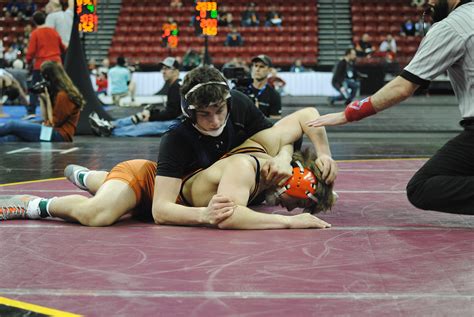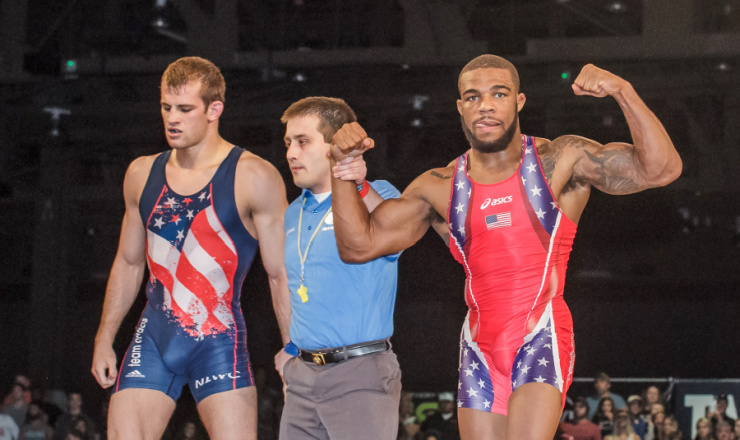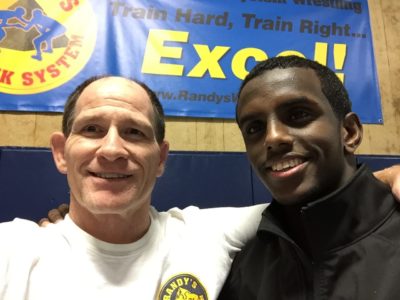I sometimes refer to it as the Mark Branch strategy.

Branch wrestled for Oklahoma State back in the days of the horse and the buggy – ala 1998.
His freshman year, he went an uninspiring 8-9 during the season…
Only to turn the tables and win the NCAA Championship.
As far as I know, he's still the only wrestler with a losing record to ever snag the top step.
The story gets even more intriguing though….
Branch placed his sophomore and junior years (2nd as a junior) – but badly injured his knee in the finals as a junior.
He came back his senior year, hobbled by a bad knee…
Ran the table going completely undefeated, capped off by another national title.
In a post-match interview, he explained that he had to completely revamp his style due to his injury.
Imagine wrestling your best while in the worst physical health.
I thought back to the numerous times I’ve had to help an injured wrestler adapt to a new way of wrestling. Its always a challenge and takes an extra level of detail to put all the pieces together.
I've assembled a guide to adapting to the two most common injuries to overcome: shoulder injuries and knee injuries.
Keep in mind that some of these recommendations will change (or become moot) depending on which shoulder, or which knee (attacking side or support side).
Okay, alibis in place, we're ready to go.
Shoulder Injury
Handfighting to attacks on your feet, as opposed to open attacks, which are more likely to leave you vulnerable to getting your arm stretched).
Adjustment to your standup so that the bad wing can’t be attacked.
Top: the injured arm becomes your support arm (perhaps you capture the opponent’s wrist with that one, as opposed to running your half or bar with it, where they can impose counter pressure). Stopping the first move so they can't force a scramble will be critical.
Knee injury
Eliminate scrambles that could cause a knee to get torqued awkwardly
Finish quickly and cleanly.
Take a methodical approach on the feet – controlling ties, slowing down the opponent by taking away his space, which limits his speed advantage
On top: shutting down your opponent’s explosive movements by gaining control early (i.e., tie up wrists, block his hips first, etc.
A lumbering, grinding style on top to wear out the opponent and control his movement.
On bottom: the quick standup off the whistle is likely not happening. The handfight standup may be your best option (we teach it in our room, it is an incredible advanced standup for shutting down leg riders and riding beasts). The handfight standup is more deliberate but much more controlling by nature. Its also the best standup to use when facing top level opponents.
Those are just a few of the adjustments you can make. For a complete gameplan, I recommend scheduling a personal session or giving our small group training a try this week.
Randy


I had a weird dream recently – and while I usually keep these to myself, this one struck me a little differently.
The dream went like this:
My daughter was offered a contract for $125 Million for 4 years – to play professional soccer at a major league level.
For perspective, she did play soccer for many years, but she played for just one year in high school, on JV – and then gave up the sport for her true passion.
Here’s the best part of the dream, though, and the whole reason for me sharing it…
She considered this offer a dilemma.
She didn’t know what to do, and was on the verge of tears over this decision.
All the while, in the background, I’m saying, “Heck yes I know what you’re going to do! Now let’s find those old cleats and get to work!”
When I awoke, I stumbled upon a different perspective: what if we turned the tables?
What if someone offered me $125M to work at the worst job possible, something I would truly hate, for 4 years? (For me, something like working in a sewer with rats crawling around all over me).
What would I do?
What would you do?
(Of course, if you already hate your job, that certainly changes your perspective on this question.)
Now let’s ask an expert….
….what would Bob Dylan do?
Bob Dylan, “the poet”, once was asked, how do you know when you are wealthy?
His response: If you wake up in the morning, and go to sleep at night, and in between, do exactly as you please, you are wealthy.”
Who’s wealthier?
The guy who is following his passion, waking up every day doing exactly as he pleases?
Or the guy who just took $125 Million to work at a terrible job for the next 4 years?
Well, for the next several years anyway, guy #1 is.
If you make it past those 4 years and pocket that $125 million in the bank, then I guess you can do exactly what you please, so there is that.
And right about now, I'll bet you are deep in thought, pondering this:
What does this have to do with wrestling?
I thought you’d never ask.
Wrestling is the ultimate sport of creativity, and of developing a style that fits the individual, a style he or she is passionate about.
And a lot of what I do is help wrestlers find their passionate path and excel at it.
If you are a leg rider, and you just love throwing those boots, for instance, you want to do that every match, every chance you get, developing hard-to-defend methods of getting them in, and ever harder to defend turns.
If you love the fireman’s carry, you want to be able to execute that move multiple ways, and excel at finishing the shot to near fall points and pins.
If you love the single leg takedown, you want to be able to hit your signature move, that single leg, on everyone (like the great John Smith – winning two Olympic titles with his single leg, even when the best in the world knew it was coming, and the world’s best coaches were plotting and scheming to stop it.)
If you need help excelling from your favorite position…
Or are being tormented by certain moves and positions (just like the guy working in the sewer with rats crawling all over him)….
I can help. Check it out here.
Randy
Leg riders – both feared and admired – are successful, in great part, because their opponents make their jobs a lot easier by not following a few basic principles.
If you apply the 4 tenets of leg ride countering, you can shut down every leg ride in wrestling.
What are those 4 principles? I’m glad you asked.
#1: Its always easier to KEEP them out than GET them out. A few key movements can prevent the opponent from getting the legs in to begin with.
#2: Position over moves. Any counter that involves giving up position – such as a switch, a sit-out, a roll – avoid at all costs against quality leg riders.
#3: He who hesitates gets tortured. Shut them down immediately or you are likely to suffer the painful consequences.
#4: Your near leg (the one he’s attacking) and your far arm are crucial. If he controls those, he controls you – and you’re in for a rough ride.
Here’s a bonus one for whenever you are facing advanced leg riders….
If you mule kick first, stop doing that. Advanced leg riders will counter it every time by lifting their foot up your middle. Once they do, it will be even harder to get the leg out.
Start with the 4 tenets of leg ride countering first, and your success rate will go up.
I’ve spent 30 years training athletes to counter legs, and devised a few quick counters that can be learned in a matter of minutes. Many wrestlers through the years have applied these and enjoyed immediate success.
If you really need to counter legs, and it has been a thorn in your pride for way too long – or you struggle in another area that you really need to fix fast….
This may be for you. It only takes 30 minutes of your time and you can get help immediately.
Randy
A special thanks to Flo Wrestling for putting on this Marquee Event for our sport.
Now, onto the show!

High level breakdowns – Taylor vs burroughs
1st period, both were working the head ties.
The first early attack was a snap by Taylor to the front headlock, which Burroughs countered by pulling the elbow in tight for a stalemate.
Taylor moved him successfully with alternating collar ties and quick efficient footwork. He Definitely had the edge when it came to moving the feet this match.
Taylor executed a very basic setup to get in deep on the single leg. Burroughs countered with a shallow whizzer, grabbing his own shin. Taylor tried to step over the far leg but Burroughs blocked with a leg stopover.
Nifty move. Had Taylor slid his knee forward, hips underneath him, and driven his head into the side (it was on the mat), his chances of finishing would have been much higher.
The setup Taylor used: a simple reach and go. It works effectively when you’ve attacked the head multiple times, forcing your opponent to react with his hand (in this case, the same side hand) The last time, instead of going to the head, he stopped short, changed levels and took his shot. In effect, he caught Burroughs reaching. The previous head ties set it up.
Near the end of the period, Burroughs went on the clock. This is the penalty in freestyle for passivity. When the clock starts, you have 30 seconds to score or your opponent gets a point.
Burroughs wasn’t able to score and Taylor took a 1-0 lead.
Here’s why Burroughs ended up on the clock….
When Burroughs attacked the head, he still couldn’t get his angle and get past Taylor’s head & hands defense to create an opening.
When Taylor attacked the head, he did so effectively – backing up Burroughs and creating openings – and he attacked off those openings. Even though he didn’t score off them, he was rewarded for being the aggressor.
Two big attacks took place in the first period: the snap to front headlock by Taylor, and the very deep single. Neither scored but both established Taylor as the aggressor.
2nd period. Taylor kept working the head, then executed a second reach and go (reaches hand up and instead of locking onto the head again, went right underneath it for the left handed single leg).
This time he was able to pick up the leg and score 1 point (Burroughs scooted out of bounds under attack, hence the 1 point instead of 2 points if he’d have secured the takedown).
Now it was 2-0 Taylor.
And now for some….
Controversy!
Burroughs attempted a shot, then slumped down in pain, appearing to tweak his groin. Taylor went behind him for the 2 point takedown.
The challenge was overturned and the 2 stayed on the board. At this point, David Taylor had a daunting 4-0 lead.
Well, if you know the history of this series, what happens next won’t surprise you…
Jordan Burroughs picked up the pace – and Taylor went on autopilot.
Taylor was still attacking the head, he just wasn’t looking to do anything with it other than slow down Burroughs.
Burroughs scored on a push-out with 50 seconds to go. 4-1.
This time, Burroughs got in on his double. Couldn’t finish but drove Taylor off the mat again. 4-2, 23 seconds to go.
Burroughs continued the pressure, Taylor backed out of bounds with 12 seconds to go. Now its 4-3!
JB continues the pace, Taylor backs out of bounds again – now its 4-4 (Taylor has criteria though due to the 2 point takedown)
Finally, Taylor has to battle in the center – can’t afford another point. He holds on, and the match ends 4-4.
Taylor wins by criteria.
Can I just say how much I dislike that a match like this can end in a tie? I know the freestyle rule – but in a showdown match like this, someone should have to outscore the other.
My 3 cents.
What you can take away from this breakdown
First point: Taylor has a devastating snap – he consistently moved Burroughs around with it.
Imagine if Burroughs had the ultimate answer to that head tie, and gained an advantage every time Taylor applied it – how much different would that match be?
If you’re a high school, junior high or youth wrestler – imagine you gaining an edge every time someone tried to work your head.
That skill is an essential element of our exceptional handfighting series.
Second point: It was a short yet crucial part of this match but it could have been enormous…
Possessing the skill to beat an opponent’s front headlock – and shut it down immediately – will win you a ton of matches.
Many times, grabbing the elbow can create a host of openings for your opponent. In this particular match, Burroughs had it tied up so deep that Taylor couldn’t do anything with it.
There are very efficient front headlock counters that instantly shut your opponent down – as well as giving you scoring opportunities. It is an essential skill, especially at tournament time.
Third Point: The attacking wrestler for most of the match won. When roles were reversed, that same attacking wrestler, now on defense, just about gave his match away.
I’d loved to have seen David Taylor stay just as aggressive and avoid giving up those back-out points.
The last time they wrestled, Taylor had an even bigger lead on Burroughs, and Burroughs came back to beat him.
Stay Aggressive! Put them on defense immediately – and Keep Them There.
If you enjoyed this blog, be sure to share it to your Facebook, instagram, twitter, and all those other social media sites that I know practically nothing about.
Randy

Today, a special bonus:
For those of you who were fortunate enough to catch the highly anticipated David Taylor / Jordan Burroughs rematch – Wow what a match!
I’ve been doing a deep dive analysis of the match, like I did the Punia/Green match back in December.
And later today, I will be posting my High Level Breakdown of the match.
Keep an eye on your inbox for it.
Randy
PS. In the High Level Breakdown I will be posting, you can discover mistakes (yes, even from high level athletes) to avoid in your own wrestling, as well as some finely detailed points missed by the casual eye, that can mean the difference between winning and losing.
Be sure to check back later today for the full analysis.

I, your Attack System Seer and Soothsayer, shalt now accurately predict the winner of tonight’s big football game. You know the one.
While many are looking at the star players – QB’s, running back, wideouts…and assessing how many points they are going to score, my perspective is slightly different. Hence my very accurate prognostication.
The winner of tonight’s game will be….
The team that puts their opponent on defense…immediately….and KEEPS them there.
Just as in wrestling, if you wait for you opponent to attack….your results are not likely to be what you were hoping for.
To use a football saying because it is apropo, especially on a day like today….
When the offense is on the field for long periods of time….
its the defense that gets tired.
Just as your opponent is likely to wear out more quickly by fighting off your constant barrage of attacks.
If you want to join us and try out this training on a one-time basis to see if its a fit for you….you can get started here
Randy

I had just started to write an email about wrestling training when all HELL broke loose in Washington.
But not just in Washington.
In a local chat that I am (still barely) in, two friends went at each others throats.
One started by making a broad statement disparaging over 70 million Americans as terrible people, simply based on their political opinions. The other took exceptional offense to this and was harshly attacked and accused of things he had no part in.
I tend to be the ‘smooth things over’ person in the chat. But after sending a very innocuous, non-political message…
I found myself on the target-end of a ruthless, vicious lie-based libelous attack on my character.
Of course I didn’t take it sitting down.
I proceeded to call out said reading-challenged SJW, who was determined to cancel-culture me and place me in a deplorable box, over – well, nothing.
The message I sent wasn’t even directed to her, and wasn’t even about the controversy.
But that’s the world we live in. People can turn on you on a dime over perceived beliefs – even ones that are far from your true, stated beliefs.
In short: I am opposed to any acts of violence, unlawful actions, etc – no matter the cause or the perpetrator. Amazing how many people (including the above SJW) oppose that viewpoint.
It took me a while to reach my epiphany. But then there it was in plain sight:
The world could learn a lot from a wrestler.
A wrestler:
- Trains for years to perfect his craft – mostly far away from the bright lights and attention that others live by
- Displays more discipline than any other athletes on the planet – managing weight, oftentimes skipping delicious holiday meals (or greatly reducing her intake “no pie for you”)…often being the one to go for a run on Thanksgiving on Christmas, even on New Years, to control ones weight and maintain top level conditioning.
- Asks for NO handouts, and is given none. He earns everything he gets with his blood and sweat, and revels in the process.
- Willingly helps her less experienced teammates starting the journey.
- Gets the most satisfaction over the successful completion of the journey – not Facebook likes, twitter hearts, or picture displayed in the paper.
Plus this: The wrestler fights his opponent toe to toe, battling for 6 minutes until both are exhausted. And at the end of the day, shakes hands with the opposition. Oftentimes hunts down his opposition later to…
Get to know him. A person from the Other Side. Wearing a different uniform. Having a different viewpoint. Believing different things.
And they become friends.
A wrestler doesn’t just throw away a friendship over a differing viewpoint. Instead, they embrace their friend, and accept her for the person she is. “The differences don’t matter because deep down I know her heart, and her heart is good.”
